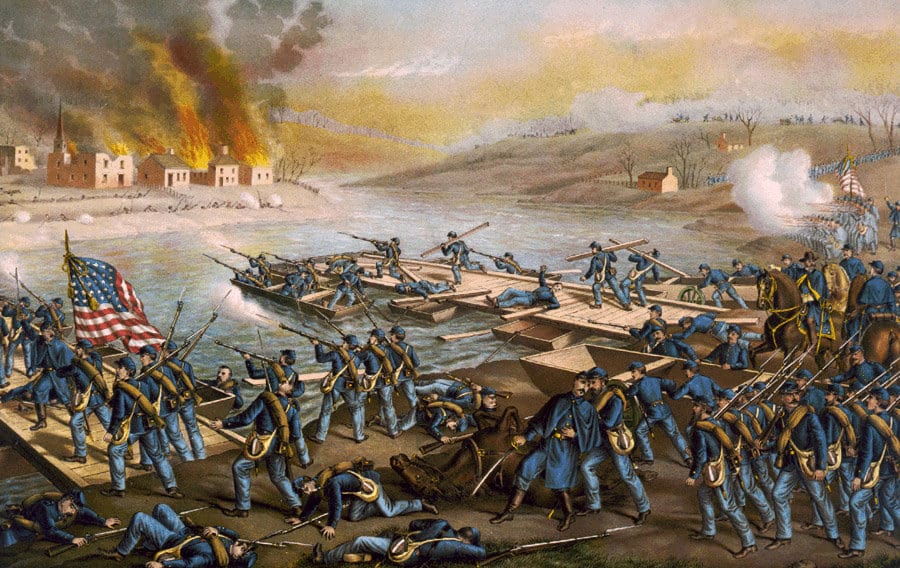
Battle of Fredericksburg: The Army of the Potomac crossing the Rappahannock: in the morning of December 13, 1862, under the command of Generals Burnside, Sumner, Hooker & Franklin. Drawing by Kurz & Allison, Art Publishers, Chicago, 1888. Source: Library of Congress [click on photo to enlarge]
December 7, 1862 – December 20, 1862
By Phil Kohn
(Phil Kohn can be reached at USCW160 @ yahoo.com.)
Confederate Maj. Gen. Thomas Hindman, with 12,000 troops, on December 7, 1862, attacks 6,000 Union troops under Brig. Gen Francis Herron at Prairie Grove, Arkansas. Shortly after the battle is joined, U.S. Maj. Gen. James Blunt arrives with an additional 7,000 Federal soldiers. The fight lasts until dark, and Hindman’s force withdraws during the night. U.S. casualties: 1,251; Confederate: 1,317. On the same day, Col. John Hunt Morgan leads Confederate cavalry against a Federal garrison at Huntsville, Tennessee. The Union loses 2,096 soldiers, including 1,800 taken prisoner. At Vicksburg, Mississippi, Lt. Gen. John Pemberton receives a communication from Jefferson Davis expressing concern about Pemberton’s ability to defend against an attack by the Federal forces of Maj. Gen. Grant.
To address criticisms that he is ignoring the Western Theater, Confederate President Jefferson Davis on December 10 embarks on a month-long information-gathering trip, with stops in Tennessee, Georgia, Alabama and Mississippi. Union troops of Maj. Gen. Ambrose Burnside continue their preparations for an assault on Fredericksburg, Virginia. In Washington, D.C., a bill to create the state of West Virginia passes in the House of Representatives. (The Senate had approved the action in July 1862.)
On December 11, intending to relieve pressure on Confederate Maj. Gen. Earl Van Dorn in Mississippi and to disrupt Union Maj. Gen. Grant’s communications, Confederate Brig. Gen. Nathan Bedford Forrest leads 2,100 cavalrymen and four guns out of Columbia, Tennessee, on a raid through western Tennessee. In the East, Brig. Gen. John Foster leads a massive Union raiding party of 10,000 infantry, 640 cavalry and 40 guns out of coastal New Bern, North Carolina, into the interior of the state. In Virginia, Maj. Gen. Ambrose Burnside’s Army of the Potomac makes a hotly contested crossing of the Rappahannock River via five pontoon bridges and enters Fredericksburg. Spending the day clearing out Confederate troops, the Federals occupy the town by nightfall.
Confederate President Jefferson Davis, on his swing through the Western Theater, meets with Gen. Braxton Bragg at Murfreesboro, Tennessee, on December 12. Convinced that Bragg is in a secure position, Davis — over the vehement objection of both Bragg and his senior commander, Gen. Joseph Johnston — orders the transfer of 7,500 soldiers to Lt. Gen. Pemberton for the defense of Vicksburg, Mississippi. The move leaves Bragg with 37,000 troops. At Fredericksburg, Virginia, both armies position themselves for the impending battle. Near Vicksburg, on the Yazoo River, the ironclad gunboat USS Cairo is sunk by an electrically detonated Confederate mine near Haines Bluff, Mississippi.
In Virginia, on December 13, Maj. Gen. Ambrose Burnside, launches his 106,000-strong Army of the Potomac against Gen. Robert E. Lee’s 72,000 Confederates positioned in and south of the city. On the Federal left, soldiers under Maj. Gen. George Meade penetrate Lt. Gen. Stonewall Jackson’s Confederate lines, but they get no support from reinforcements and must withdraw. On the Federal right, wave after wave of Union soldiers is sent to attack Lt. Gen. James Longstreet’s strongly entrenched troops on Marye’s Heights, above the town. Confederate infantrymen are behind a stone wall bordering a sunken road, with their artillery above and behind them. The Yankees, who must traverse a long, open slope with only shallow depressions for shelter, are slaughtered. U.S. casualties: 12,700 killed or wounded. Confederate casualties: 5,300. At the end of the day, the Federals remain in Fredericksburg and the Confederates remain on the ridges above them.
On December 14, Maj. Gen. Burnside wishes to continue the attacks on the Confederate positions but is dissuaded by his subordinates. The defeated Army of the Potomac in and around Fredericksburg, Virginia, prepares to move back across the Rappahannock River, whence it came. Although vulnerable, the Federals are not attacked by Lee’s Confederates — the Northern army still outnumbers the Southerners, and it is protected by massive artillery batteries across the river. In the Deep South, U.S. Maj. Gen. Nathaniel Banks arrives in New Orleans on December 14 to assume military command from Maj. Gen. Benjamin Butler, who departs the next day. Many residents of the Crescent City are elated to see the widely reviled “Beast” Butler leave. In North Carolina, Confederates at Kinston are routed by the massive raiding force of Brig. Gen. John Foster, which sacks the city.
Maj. Gen. U.S. Grant, targeting Vicksburg, Mississippi, on December 15 begins experiencing communications problems with his various forces caused by the actions of the Confederate cavalry of Brig. Gen. Nathan Bedford Forrest.
With his Army of the Potomac occupying Falmouth, Virginia, across from Fredericksburg, Maj. Gen. Ambrose Burnside on December 16 makes a statement accepting full responsibility for the debacle on December 13. Brig. Gen. John Foster’s Union troops push the Confederates out of Whitehall, North Carolina, and burn the CSS Neuse, under construction there, as they continue to move westward in the Tar Heel State.
In Washington, because of continuing bickering and conflicts with Treasury Secretary Salmon P. Chase, Secretary of State William Seward tenders his resignation to President Lincoln on December 17. Three days later, Secretary Chase submits his resignation, also. After numerous meetings with the two men and others, Lincoln refuses to accept either resignation, asking both to stay on. They agree, but tensions remain. Brig. Gen. John Foster’s troops attack Goldsboro, North Carolina, burning the railroad bridge across the Neuse River, the primary target of the raid. Afterward, they make their way back east to New Bern. In the West, Maj. Gen. Grant publishes his General Order Number 11. Although it deals with speculation and profiteering in his department (which includes parts of Kentucky, Tennessee and Mississippi), it specifically singles out Jews: “The Jews, as a class violating every regulation of trade established by the Treasury Department and also department orders, are hereby expelled from the department within twenty-four hours from receipt of this order.” Although Grant’s order is rescinded several weeks later, his reputation is tarnished by the adverse publicity that arises.
On December 18, Maj. Gen. Earl Van Dorn leads 3,500 Confederate cavalrymen behind the army of U.S. Maj. Gen. Grant, which is heading south toward Vicksburg. Brig. Gen. Forrest’s cavalry defeats a Federal garrison at Lexington, Tennessee.
Forrest’s cavalry on December 19 strikes the Mobile & Ohio Railroad near Three Way, Tennessee, destroying tracks and rolling stock, as well as stations and bridges in the vicinity, further hampering Grant’s movements towards Vicksburg.
On December 20, Maj. Gen. William T. Sherman embarks on a water-borne operation that’s part of Grant’s plan for taking Vicksburg, Mississippi. Sherman leads 32,000 U.S. troops in 50 boats down the Mississippi River from Memphis. Confederate Maj. Gen. Van Dorn’s men capture the huge Federal depot at Holly Springs, Mississippi, destroying $1.5 million in supplies and taking 1,500 prisoners. The Confederates also burn 4,000 cotton bales to prevent them from falling into Union hands. The Confederate cavalry of Brig. Gen. Nathan Bedford Forrest captures Trenton, Tennessee. The losses force Grant to halt his overland advance on Vicksburg, thwarting his plan to join forces with Sherman’s men moving down the Mississippi River. Grant withdraws his force some 60 miles northward, from Oxford, Mississippi, to La Grange, Tennessee.







